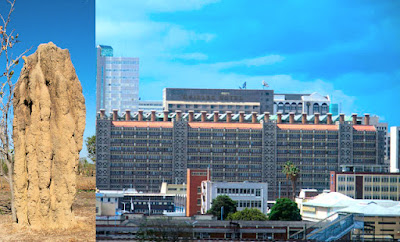Architect - Le Corbusier
 Charles-Edouard Jeanneret, who chose to be known as Le Corbusier (October 6, 1887 – August 27, 1965), was a Swiss-born architect and writer, who is famous for his contributions to what now is called Modern Architecture. He is considered to be both Swiss and French, having become a citizen of France in his 30's.
Charles-Edouard Jeanneret, who chose to be known as Le Corbusier (October 6, 1887 – August 27, 1965), was a Swiss-born architect and writer, who is famous for his contributions to what now is called Modern Architecture. He is considered to be both Swiss and French, having become a citizen of France in his 30's.He was a pioneer in theoretical studies of modern design and was dedicated to providing better living conditions for the residents of crowded cities. His career spanned five decades, with his iconic buildings constructed throughout central Europe, India, Russia, and one structure each in North and South America. He was also an urban planner, painter, sculptor, writer, and modern furniture designer.
It was Le Corbusier's Villa Savoye (1929-1931) that most succinctly summed up his five points of architecture that he had elucidated in the journal L'Esprit Nouveau and his book Vers une architecture, which he had been developing throughout
 the 1920s. First, Le Corbusier lifted the bulk of the structure off the ground, supporting it by pilotis – reinforced concrete stilts. These pilotis, in providing the structural support for the house, allowed him to elucidate his next two points: a free façade, meaning non-supporting walls that could be designed as the architect wished, and an open floor plan, meaning that the floor space was free to be configured into rooms without concern for supporting walls. The second floor of the Villa Savoye includes long strips of ribbon windows that allow unencumbered views of the large surrounding yard, and which constitute the fourth point of his system. The fifth point was the Roof Garden to compensate the green area consumed by the building and replacing it on the roof. A ramp rising from the ground level to the third floor roof terrace, allows for an architectural promenade through the structure. The white tubular railing recalls the industrial "ocean-liner" aesthetic that Le Corbusier much admired. As if to put an exclamation point on Le Corbusier's homage to modern industry, the driveway around the ground floor, with its semicircular path, measures the exact turning radius of a 1927 Citroen automobile.
the 1920s. First, Le Corbusier lifted the bulk of the structure off the ground, supporting it by pilotis – reinforced concrete stilts. These pilotis, in providing the structural support for the house, allowed him to elucidate his next two points: a free façade, meaning non-supporting walls that could be designed as the architect wished, and an open floor plan, meaning that the floor space was free to be configured into rooms without concern for supporting walls. The second floor of the Villa Savoye includes long strips of ribbon windows that allow unencumbered views of the large surrounding yard, and which constitute the fourth point of his system. The fifth point was the Roof Garden to compensate the green area consumed by the building and replacing it on the roof. A ramp rising from the ground level to the third floor roof terrace, allows for an architectural promenade through the structure. The white tubular railing recalls the industrial "ocean-liner" aesthetic that Le Corbusier much admired. As if to put an exclamation point on Le Corbusier's homage to modern industry, the driveway around the ground floor, with its semicircular path, measures the exact turning radius of a 1927 Citroen automobile. Le Corbusier explicitly used the golden ratio in his Modulor system for the scale of architectural proportion. He saw this system as a continuation of the long tradition of Vitruvius, Leonardo da Vinci's "Vitruvian Man", the work of Leon Battista Alberti, and others who used the proportions of the human body to improve the appearance and function of architecture. In addition to the golden ratio, Le Corbusier based the system on human measurements, Fibonacci numbers, and the double unit.
Le Corbusier explicitly used the golden ratio in his Modulor system for the scale of architectural proportion. He saw this system as a continuation of the long tradition of Vitruvius, Leonardo da Vinci's "Vitruvian Man", the work of Leon Battista Alberti, and others who used the proportions of the human body to improve the appearance and function of architecture. In addition to the golden ratio, Le Corbusier based the system on human measurements, Fibonacci numbers, and the double unit.He took Leonardo's suggestion of the golden ratio in human proportions to an extreme: he sectioned his model human body's height at the navel with the two sections in golden ratio, then subdivided those sections in golden ratio at the knees and throat; he used these golden ratio proportions in the Modulor system.
Le Corbusier's 1927 Villa Stein in Garches exemplified the Modulor system's application. The villa's rectangular ground plan, elevation, and inner structure closely approximate golden rectangles.
Le Corbusier placed systems of harmony and proportion at the centre of his design philosophy, and his faith in the mathematical order of the universe was closely bound to golden section and Fibonacci the series, which he described as "[...] rhythms apparent to the eye and clear in their relations with one another. And these rhythms are at the very root of human activities. They resound in Man by an organic inevitability, the same fine inevitability which causes the tracing out of the Golden Section by children, old men, savages, and the learned."



Comments